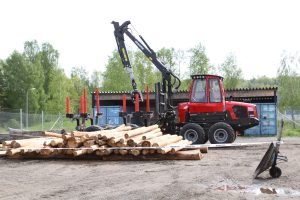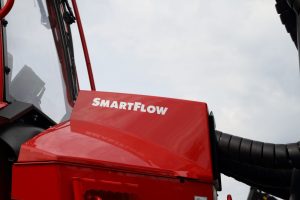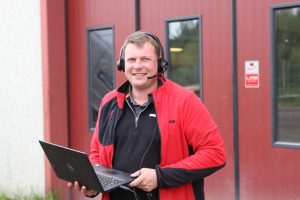We already wrote about Komatsu’s crane tip control Smart Crane. I must admit I never really knew what it´s like to operate a crane with this function. So, when Komatsu Forest had the good taste of organizing a (corona-safe) demo of their Smart Crane, in combination with the Smart Flow system, close to me, I of course had to go there and have a look. I must say, a lot has happened since I operated forest machines.
Smart Crane and Smart Flow
One could say that the Smart Crane concept is an extension of the already existing hydraulic system Smart Flow by Komatsu. The combination of the two gives a good working environment for the operator that, hopefully, can work more efficient.
To make it simple you can say that Smart Flow is a crane damping system, and Smart Crane is a crane tip control. I got to try both myself, separately, and compare with the functions disconnected. Maybe I was most impressed by the damping system (Smart Flow). When “dropping” the crane with a full grapple from a high level, and letting the lever loose creating a sudden stop, you (I, an old operator) expected the machine to shake a lot. But it didn´t. One nod of the crane, that was it and then it was still. It was such a strange feeling that I had to try it repeatedly to believe it.
The computer keeps track of the grapple
As for the crane tip control (Smart Crane), the surprise wasn´t as big. Here I must mention that I mainly operated harvesters back in the days, not so many forwarders, and quite a lot of harvesters without telescope crane. I have heard people say that it´s difficult to avoid using the telescope, letting the machine do that, at first when you start using crane tip control. I did, however, not have that problem. I found myself at ease with this system immediately.
The Smart Crane system does basically one thing. It keeps track of where the crane tip, in this case the grapple, is. Simple moves with the crane, up and down, out and in, is made with only one of the levers. If you want to lift the grapple straight up, you use the right lever only and the grapple will move vertically all the way. The computer adjusts the telescope and the outer boom automatically.
If you want to move the grapple from the machine and out, you use the left lever only. The computer will make sure the grapple moves straight horizontally on the same height over the ground all the way. The same goes, of course, for when you move the grapple towards the machine.
You can see those moves in the film here below.
Old dogs do learn – if they want to
The way I see it, it must be quite easy for experienced machine operators to get used to those functions. To get rid of most shakes and vibrations in the cabin must be good for both body and soul. Probably you can even produce more on a shift and make more money.
For a beginner it´s of course perfect to get that much help from the start. But, and here is the only (?) downside I see with it, if a beginner who learns to operate a crane with systems like Smart Flow and Smart Crane eventually end up in an older machine that doesn´t have those modernity’s, he or she will have a problem. Maybe it´s better to learn crane operating the old-fashioned way from the start after all? Easy for me to say – I learned crane operating with six levers.
Corona safe demo
Not only the cranes and the flows have to be smart nowadays. In times of a pandemic, it takes fantasy to organize demos. There has been a variety of methods and Komatsu Forest presented one at this time.
The demo was scheduled. Each customer got one hour and was invited at a certain time. During the demo, the instructor stood outside the machine and spoke with the customer in the cabin through a headset. Speakers and a microphone were set up in the cab for this. All to avoid unnecessary contact.
It´s amazing how problems help people to find solutions. It will for sure be interesting to see what happens after the pandemic and all the restrictions. Will it all go back to normal, or are we seeing the new normal now?
Film and more info
Find out more about the Komatsu smart things here.
And here is a film from my visit:
Film & photos: Per Jonsson















